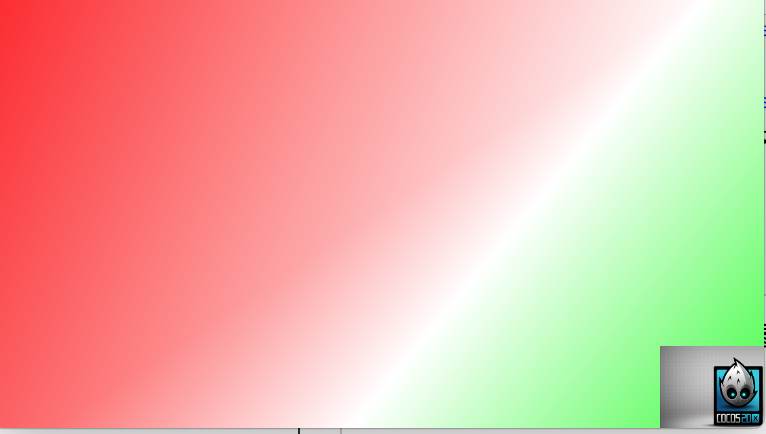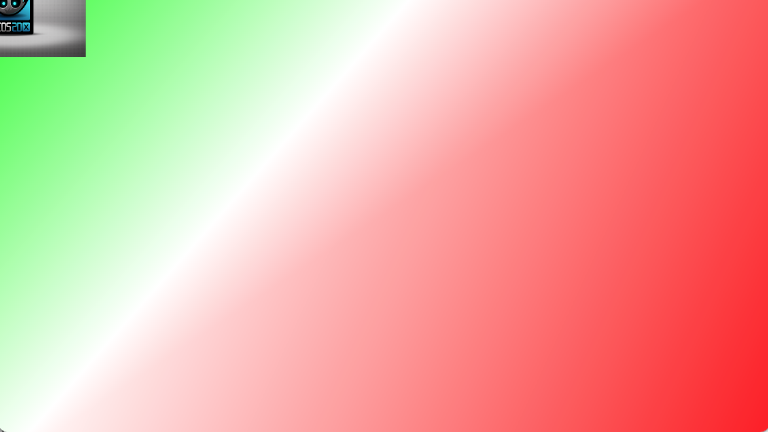本文写一个使用动态更新属性变量的自定义着色器。在这个例子中,小图标的位置根据手指的触摸而移动,以屏幕重点为参照物,屏幕中向下的部分根据手指的点击乘以一个绿色的颜色值,向上的部分乘以一个红色的颜色值。
可以把计算过程分为三个步骤
1 利用手指的点击计算出小图标当前的位置,并将位置传入到顶点着色器中,因为他对每个顶点都是一样的,所以我们可以使用一个全局变量u_center
2 顶点着色器根据顶点与小球的距离,计算出一个-1~1的权重值,这个值作为易变变量v_high 传递给片段着色器。大于0表示手指向上点击,小于0表示向下倾斜
3 经过光栅化插值的权重值在片段着色器中用来修改片段的颜色,大于0表示向上倾斜,乘以一个红色的颜色值,反之,乘以一个绿色的颜色值。
我们把自定义着色器作用在一个Sprite元素中,因为Sprite执行过程中会对顶点属性,全局变量的值或者回调方法进行访问。
首先我们新建名为dynamic_shader.vert和dynamic_shader.frag
const char* dynamic_shader_vert = STRINGIFY( attribute vec4 a_position; attribute vec4 a_color; uniform vec3 u_center;//小图标坐标 varying vec4 v_fragmentColor; varying float v_high;//权重值 void main() { gl_Position = CC_MVPMatrix * a_position; v_fragmentColor=a_color; //求四个顶点与center的距离dis vec2 disV=vec2(a_position.x-u_center.x,a_position.y-u_center.y); float dis=sqrt(disV.x*disV.x+disV.y*disV.y); //u_center.z为斜对角距离的一半,通过这样计算出-1~1的权重值 float high=(dis-u_center.z)/u_center.z; v_high=high; }
const char* dynamic_shader_frag = STRINGIFY( #ifdef GL_ES precision lowp float; #endif varying vec4 v_fragmentColor; varying float v_high; uniform vec4 u_highColor;//向上偏移颜色 红色 uniform vec4 u_lowColor; void main() { if(v_high>0.0)//权重值大于0,比如小图标在右上角,左下角的顶点的权重值是大于0的 gl_FragColor=v_fragmentColor*u_highColor*v_high; else gl_FragColor=v_fragmentColor*u_lowColor*-v_high; vec4 white=vec4(1.,1.,1.,1.); //gl_FragColor=gl_FragColor+white*(1. -gl_FragColor.a)*white; //如果不加白色,中心的权重值为0,他的位置的gl_FragColor就会是黑色,加上一个白色的底,更好看 gl_FragColor=gl_FragColor+white*(1.0 -gl_FragColor.a);//最边缘的 .a为1 ,中心的.a为0,所以中心为白色 // gl_FragColor=vec4(gl_FragColor.r,gl_FragColor.g,gl_FragColor.b,0.4); } );
我们这里要把这个作为sprite的着色器,但是里面没有纹理,其实这个sprite的作用就和LayerColor差不多了,但是sprite在执行着色过程中会执行我们后期赋值的顶点属性和全局属性,或者回调函数,而LayerColor不会执行这些,体现不出如何使用自定义着色器,所以这里把sprite作为演示对象。
以下是代码
//小图标 auto size=Size(480, 320); auto dot=Sprite::create("aaa.png"); scene->addChild(dot,10); dot->setScale(0.2); dot->setPosition(size.width/2,size.height/2); //自定义着色器的sprite auto sprite=Sprite::create("aaa.png"); scene->addChild(sprite,5); sprite->setContentSize(designSize); sprite->setColor(Color3B::WHITE); sprite->setPosition(size.width/2,size.height/2); auto _halfDis=sqrtf(size.width*size.width+size.height*size.height)/2; auto _center=Vec2(size.width/2,size.height/2); // 创建GLProgram,传递我们自定义的着色器 auto program=GLProgram::createWithByteArrays(dynamic_shader_vert, dynamic_shader_frag); auto pstate=GLProgramState::create(program); // 把sprite的着色器设置为创建的pstate sprite->setGLProgramState(pstate); auto _highColor=Color4B::RED; auto _lowColor=Color4B::GREEN; /* opengl对顶点属性值的归一化是按照数据类型计算的,他并不能识别颜色值的意义,因此利用GL 的归一化会导致错误的颜色值,所以这里将颜色值在客户端归一化 */
//赋值全局变量,这两个颜色在过程中是不变的,所以我们可以这样设置
pstate->setUniformVec4("u_highColor",Vec4(_highColor.r/255.0,_highColor.g/255.0,_highColor.b/255.0,_highColor.a/255.0)); pstate->setUniformVec4("u_lowColor",Vec4(_lowColor.r/255.0,_lowColor.g/255.0,_lowColor.b/255.0,_lowColor.a/255.0)); //u_center代码手指的移动,过程中是变化的,所以我们用setCallback的形式设置。
//这里的回调是在 _glProgramState->apply(_mv);中执行 pstate->setUniformCallback("u_center",[&_center,&_halfDis](GLProgram* glProgram, Uniform* uniform){ glProgram->setUniformLocationWith3f(uniform->location, _center.x, _center.y, _halfDis); // CCLog(">>>>>>>>%f",_halfDis); // CCLog(">>>>>>>>========%f %f",_center.x,_center.y); }); auto touchListener = EventListenerTouchOneByOne::create(); touchListener->onTouchBegan =[this,size,dot,&_center,scene](Touch*touch, Event*event)->bool{ // auto location = scene->convertToNodeSpace(touch->getLocation()); auto location = touch->getLocation(); _center.x=location.x; _center.y=location.y; if(_center.x<0)_center.x=0; else if (_center.x>size.width)_center.x=size.width; if(_center.y<0)_center.y=0; else if (_center.y>size.height)_center.y=size.height; dot->setPosition(_center); return false; }; Director::sharedDirector()->getEventDispatcher()->addEventListenerWithSceneGraphPriority(touchListener, scene);
这里关键的一点就是对U_center属性的设置。在callback中对其进行重新赋值,原理是在以下代码中
void GLProgramState::apply(const Mat4& modelView) { //使用当前程序 applyGLProgram(modelView); //执行顶点的相关操作 applyAttributes(); //执行全局变量的相关操作 applyUniforms(); } void GLProgramState::applyUniforms() { // set uniforms for(auto& uniform : _uniforms) { uniform.second.apply(); } } void UniformValue::apply() { if(_useCallback) { (*_value.callback)(_glprogram, _uniform); } else { switch (_uniform->type) { case GL_SAMPLER_2D: _glprogram->setUniformLocationWith1i(_uniform->location, _value.tex.textureUnit); GL::bindTexture2DN(_value.tex.textureUnit, _value.tex.textureId); break; case GL_INT: _glprogram->setUniformLocationWith1i(_uniform->location, _value.intValue); break; case GL_FLOAT: _glprogram->setUniformLocationWith1f(_uniform->location, _value.floatValue); break; case GL_FLOAT_VEC2: _glprogram->setUniformLocationWith2f(_uniform->location, _value.v2Value[0], _value.v2Value[1]); break; case GL_FLOAT_VEC3: _glprogram->setUniformLocationWith3f(_uniform->location, _value.v3Value[0], _value.v3Value[1], _value.v3Value[2]); break; case GL_FLOAT_VEC4: _glprogram->setUniformLocationWith4f(_uniform->location, _value.v4Value[0], _value.v4Value[1], _value.v4Value[2], _value.v4Value[3]); break; case GL_FLOAT_MAT4: _glprogram->setUniformLocationWithMatrix4fv(_uniform->location, (GLfloat*)&_value.matrixValue, 1); break; default: CCASSERT(false, "Invalid UniformValue"); break; } } }
_value是一个联合体,可以是float数组,可以是纹理结构体,也可以是lamada函数,如下
union U{ //联合,U可能是下面任何一个值
float floatValue;
int intValue;
float v2Value[2];
float v3Value[3];
float v4Value[4];
float matrixValue[16];
struct {
GLuint textureId;
GLuint textureUnit;
} tex;
std::function<void(GLProgram*, Uniform*)> *callback;
U() { memset( this, 0, sizeof(*this) ); }
~U(){}
U& operator=( const U& other ) {
memcpy(this, &other, sizeof(*this));
return *this;
}
} _value;
如果运行没有问题的话,效果如图所示:



以上就是自定义着色器的使用过程,以及怎样对已有元素使用自定义的着色器程序。这种着色器子系统是开发者不需要继承就可以使用自定义着色器。